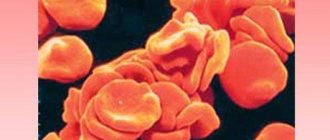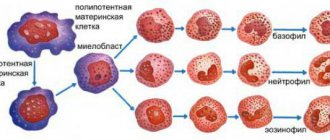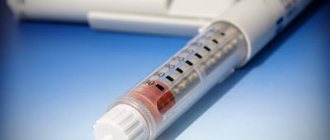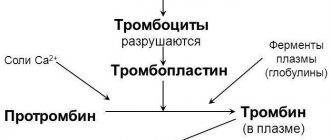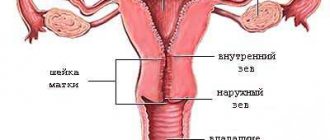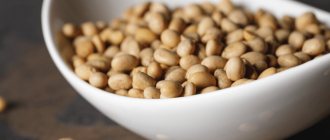Cholesterol
Total cholesterol (cholesterol) is an essential substance of the human body.
It is the basis of the membranes of all cells and is used for the synthesis of steroid hormones, vitamin D and bile acids. Most of the cholesterol the body needs is synthesized in the liver, while a smaller portion comes from food. Cholesterol circulates in the blood as part of complex complexes called lipoproteins. Despite the obvious necessity of cholesterol for the body, its excess in the blood can lead to atherosclerosis - the formation of plaques on the walls of blood vessels that narrow the lumen. There are several fractions of total cholesterol, two of which are necessary to establish the correct diagnosis and prognosis:
- LDL (bad cholesterol) Low-density lipoprotein cholesterol is the main transport form of total cholesterol. It transports total cholesterol to tissues and organs. Determination of LDL cholesterol is carried out in order to detect an increase in cholesterol in the blood. With the development of vascular diseases, it is LDL cholesterol that is the source of cholesterol accumulation in the walls of blood vessels. The risk of developing atherosclerosis and coronary heart disease is more closely related to LDL cholesterol than to total cholesterol.
- VLDL Very low density lipoproteins - refers to “bad” cholesterol, but its presence in the blood is a physiological norm, since it is with the help of VLDL that fats and cholesterol are transported during the digestion of food from the intestines to the blood.
With its help, fat is extracted from fat deposits when there is a lack of calories. That is why there is no point in taking any measures to combat it.
- HDL (good cholesterol) High-density lipoprotein cholesterol transports fats and cholesterol from one group of cells to another. Thus, HDL cholesterol transports cholesterol from the vessels of the heart, heart muscle, arteries of the brain and other peripheral organs to the liver, where bile is formed from cholesterol. HDL cholesterol removes excess cholesterol from the body's cells.
Increased atherogenicity coefficient, what to do?
If the results of laboratory tests reveal a high coefficient, this indicates that the body produces predominantly “bad” cholesterol. Despite the lack of evidence about the direct and main role of fatty alcohol in the formation of cardiovascular diseases and pathologies, it is not worth the risk. Measures should be taken immediately to normalize the indicator.
You can do this in two ways:
- Change your lifestyle and diet.
- Start taking specialized medications.
Lifestyle
The increase in the index is due to a number of reasons:
- Presence of bad habits (smoking, alcohol abuse, drug use). Psychoactive substances “inhibit” normal fat metabolism and disrupt fat synthesis.
- Sedentary lifestyle. Physical inactivity leads to stagnant processes. Fats and fatty complexes are synthesized too actively.
From this we can conclude that to normalize the index you need:
- Lead a more active lifestyle. Strong physical activity can normalize the concentration of cholesterol in the blood and lipid metabolism. A healthy person is recommended to do 4 sessions during the week, 35-40 minutes each. If you have a history of diseases, you should consult a doctor to exclude contraindications and select the optimal physical activity regimen.
- Give up bad habits.
Diet
It is advisable to limit consumption or completely avoid the following foods:
- Sausages;
- Fatty fermented milk products (sour cream, cream, butter);
- Products rich in trans fats (margarine, palm oil spreads, etc.)
On the contrary, you should include in your diet:
- Fish. Cod, hake, flounder and others. Frying should be avoided, giving preference to boiling.
- Nuts (almonds, walnuts). Nuts contain monosaturated fatty compounds and can reduce the amount of cholesterol in the blood.
- Fruits vegetables. Especially beets. Potatoes are not recommended.
- Chocolate and green tea.
- Garlic.
- Cereals.
As well as other products containing fats of vegetable rather than animal origin.
Read more: How to lower cholesterol at home, without drugs?
Taking medications is another way to reduce the atherogenic index. However, statins (cholesterol-lowering drugs) have many side effects and should be taken strictly on the advice of a doctor and in a very limited number of cases.
Triglycerides
Triglycerides are the most important source of energy for cells; they are derivatives of glycerol. Triglycerides enter the human body with food, then they are synthesized in adipose tissue, then in the liver and in the intestines. The level of triglycerides in a person’s blood directly depends on age. To diagnose atherosclerosis, as well as many other diseases, triglyceride analysis is used. Plant seeds, liver and adipose tissue contain triglycerides, which are an essential part of human food.
Complexes with this research
Male anti-aging diagnostics Monitoring of key indicators in men aged 40+ 13,300 ₽ Composition
Fitness monitoring Examination to select physical activity and monitor the condition of the body 6,780 ₽ Composition
Women's anti-aging diagnostics Monitoring of basic blood parameters in women aged 40+ 12,070 ₽ Composition
IN OTHER COMPLEXES
- Anti-aging diagnostics in postmenopause RUB 12,630
- Advanced anti-aging diagnostics in postmenopause RUB 29,230
- Advanced male anti-aging diagnostics RUB 33,710
- Metabolic profile RUB 5,900
- Lipidogram. Diagnosis of atherosclerosis RUB 1,480
Calculation of the atherogenic index
The atherogenic coefficient is an indicator that reflects the degree of risk of developing heart and vascular disease.
In the development of atherosclerotic plaques in blood vessels, not only an increase in the total amount of cholesterol in the blood is important, but also the ratio between “bad” and “good” cholesterol. This is what the atherogenicity coefficient reflects. It is calculated using the following formula: KA = (total cholesterol - HDL)/HDL .
The optimal atherogenicity coefficient is 2-3.
Norm of atherogenic coefficient
When calculating the atherogenicity coefficient, experts use a simple formula:
Atherogenicity coefficient (Atherogenicity Index) = (Total cholesterol - HDL) / HDL
* HDL - high density lipoproteins.
The norm of the atherogenic index varies from laboratory to laboratory; in general, this indicator is normal in the range from 2 to 2.5 units (but not higher than 3.2 for women and 3.5 for men). An indicator above the specified norm may indicate the presence of atherosclerosis. However, the coefficient alone does not allow us to accurately state the presence of the disease.
If the atherogenic index is below the specified norm, this is not a cause for concern. This result does not matter.
Apolipoproteins
- Apolipoprotein A1 is a protein that plays a specific role in lipid metabolism and is also the main protein component of HDL. Activates enzymes that unload cholesterol from tissues into HDL particles and allow them to be recognized by liver receptors and bind to these receptors. Apolipoprotein A1 concentration can be measured directly and tends to fall and rise with HDL levels.
- Apolipoprotein B is the main protein in all lipoproteins, with the exception of HDL. Reflects the danger of developing atherosclerotic lesions, thus being its marker. In addition, apolipoprotein B plays a major role in the recognition and binding of LDL by special receptors located on the membranes of almost all cells of the body, in addition to red blood cells and cells of the nervous system.
Lipidogram (triglycerides, cholesterol, HDL, LDL, atherogenicity coefficient)
A lipidogram is a comprehensive study that allows you to determine the amount of lipids of various fractions and their ratio in the blood serum. The study determines the distribution, type and volume of fats. The main goal of the study is to identify pathologies of lipid metabolism, assess the likelihood of development and predict the course of diseases of the cardiovascular system. This test can also be used to diagnose pathologies of the liver, kidneys, pancreas, brain, monitor the effectiveness of treatment and the recommended diet.
The complex includes the definition:
- triglyceride content (in the “Price” section on the official website of medical item 612);
- total cholesterol (cholesterol) level (item 615);
- high density lipoprotein (HDL) cholesterol content (item 611);
- low-density lipoprotein (LDL) cholesterol content (item 613);
- atherogenic coefficient.
Triglycerides
Triglycerides are the main blood lipids. One source of triglycerides is the food we eat. They are also produced by fat cells, liver cells and intestinal cells. Blood does not contain this type of lipid in a free state, but only in combination with proteins, in the form of macromolecules called lipoproteins. The main transporters of triglycerides in the bloodstream are very low-density lipoproteins (VLDL).
Triglycerides are the main lipids found in body fat and in food. One molecule consists of triatomic glycerol and three residues of higher fatty acids (mainly palmitic, stearic, oleic and linoleic acids). The initial accumulation of triglycerides occurs in fat cells. Then a process of hydrolysis occurs, the result of which is their breakdown into glycerol and fatty acids and release into the circulation system. The main task of triglycerides is to provide cells with energy.
An increase in triglyceride levels causes changes in other lipid profile parameters and is associated with pathologies such as diabetes mellitus, hypertension, and obesity. Also, excess triglyceride levels are an indicator of a high risk of developing atherosclerosis, cerebrovascular disease, and coronary heart disease.
Cholesterol (cholesterol)
Cholesterol (cholesterol) is a fat-like organic compound, a lipophilic (fatty) alcohol found in the membranes of human and animal cells. Its amount in the blood serum characterizes the quality of lipid metabolism and reflects the likelihood of developing cardiovascular diseases and the complications they can cause.
Replenishment of cholesterol occurs both directly in the body (it is produced by the liver, intestines, gonads, kidneys and adrenal glands (about 80%)) and with food products of animal origin (most of all it is found in meat, butter, eggs). Cholesterol does not dissolve in water. Its transporter is lipoprotein complexes.
Lipoprotein cholesterol is divided into several fractions: HDL - high-density lipoproteins, LDL - low-density lipoproteins; VLDL – very low density and others. They have different compositions and perform different tasks. Total cholesterol combines three types:
- cholesterol, which is part of circulating lipoproteins;
- cholesterol, which is combined with fatty acids (esterified);
- free cholesterol.
Age has a significant impact on the amount of cholesterol in the blood. In infants, the concentration does not exceed 3 mmol/l. As a person grows older, gender differences begin to affect themselves. For men, cholesterol levels rise until old age, and then it decreases. In women, the dynamics are slower until menopause, and then cholesterol levels can exceed those of men. The dynamics of the process are influenced by hormones that can increase (androgens) or decrease (estrogens) the concentration of total cholesterol in the blood.
Total cholesterol levels are examined to determine the likelihood of atherosclerosis and to determine any abnormalities in lipid metabolism. Elevated cholesterol levels provoke the development of atherosclerosis of blood vessels and cardiac ischemia. Based on data on cholesterol levels, and taking into account existing diseases, age, gender, blood pressure, smoking habits, an individual forecast is made about the degree of possibility of developing complications caused by atherosclerosis (heart attack, stroke).
Cholesterol levels are reduced through diet - the effect can be 10-15%. The level of total cholesterol that must be maintained to minimize the possibility of cardiovascular disease should not exceed 5.2 mmol/L. During treatment, special attention is paid to reducing LDL cholesterol levels.
HDL cholesterol
High-density lipoproteins (HDL) differ from other lipid fractions in their low cholesterol content and the ability to transfer it from the cells of the heart vessels, cerebral arteries, and other peripheral organs to the liver, where it is converted into bile acids, utilized and excreted from the body.
Due to its antiatherogenic effect (i.e., action that reduces the likelihood of developing atherosclerosis), high-density lipoproteins are the only fraction that prevents the formation of atherosclerotic plaques in blood vessels, thereby preventing the development of cardiovascular diseases (therefore, HDL has another name - “good "cholesterol).
A high level of HDL cholesterol is a favorable indicator that reduces the risk of heart and vascular pathologies. When its level is low, there is a high probability of early development of atherosclerosis and cardiovascular diseases, often combined with metabolic disorders, which can manifest as high levels of triglycerides, insulin, and type 2 diabetes in the blood. Men have lower average HDL levels than women.
LDL cholesterol
Low-density lipoproteins (LDL) belong to beta lipoproteins and are the main carriers of cholesterol, transporting it in the form of esters. Research results have convincingly proven that the risk of developing atherosclerosis and, as a consequence, diseases of the cardiovascular system is significantly higher with elevated HDL cholesterol than with total cholesterol. This fact is explained by the fact that it is low-density lipoproteins that are the main transporters of cholesterol, both from food and produced by the liver, to the cells of tissues and organs. In people with a hereditary predisposition to high cholesterol or in those who abuse fatty meat and dairy products, LDL cholesterol accumulates on the inner surface of the walls of blood vessels, which contributes to the formation of atheroclerotic plaques, narrowing their lumen and causing the formation of blood clots. In light of the above, LDL cholesterol testing has important diagnostic value not only in determining the likelihood of developing atherosclerosis and subsequent complications, but also in monitoring the effectiveness of cholesterol-lowering drugs.
A decrease in the level of total cholesterol, increased due to the LDL fraction (this is reflected by an increase in the calculated value - the atherogenic coefficient), can be achieved by prescribing a diet and lipid-lowering therapy.
Atherogenic coefficient
To determine the likelihood of developing atherosclerosis, coronary heart disease and other pathologies of the heart and blood vessels, knowing only the total level of cholesterol in the blood is not enough. Adequate diagnosis can be carried out only on the basis of determining the ratio of lipid fractions and identifying the predominant one. The atherogenicity coefficient is a reliable indicator of the degree of lipid metabolism disorder and the risk of developing atherosclerosis. It is equal to the ratio of the difference between total cholesterol and HDL cholesterol to total high-density lipoprotein cholesterol:
KA = (total cholesterol - HDL cholesterol)/HDL
If the coefficient is higher than normal, then there is a high probability of developing cardiovascular pathologies.
A comprehensive study of lipid fractions (lipidogram) is recommended for everyone starting from the age of 20 every five years. If family members had a history of high cholesterol or heart disease at a young age, it is recommended that their children first take a cholesterol test between the ages of 2 and 10 years.
Indications for the purpose of analysis
- Atherosclerosis and related diseases of the cardiovascular system, in particular coronary heart disease (prognosis, assessment of the risk of complications, diagnosis).
- Liver and kidney diseases.
- Endocrine pathology (hypothyroidism, diabetes mellitus).
- Screening examinations.
Preparation It is recommended to donate blood in the morning, between 8 and 11 am. Blood is drawn on an empty stomach, after 10-12 hours of fasting. It is allowed to drink water without gas and sugar. On the eve of the examination, food overload should be avoided.
References
- Kukharchuk, V.V., Ezhov, M.V., Sergienko, I.V. and others. Clinical recommendations of the Eurasian Association of Ardiologists (EAA) / National Society for the Study of Atherosclerosis (NOA) for the diagnosis and correction of lipid metabolism disorders for the prevention and treatment of atherosclerosis. Eurasian Journal of Cardiology, 2021. - T. 2. - P. 6-29.
- Quispe, R., Elshazly, M., Zhao, D. et al. Total cholesterol/HDL-cholesterol ratio discordance with LDL-cholesterol and non-HDL-cholesterol and incidence of atherosclerotic cardiovascular disease in primary prevention: The ARIC study. Eur J Prev Cardiol., 2021. - Vol. 27(15). - P. 1597-1605.

